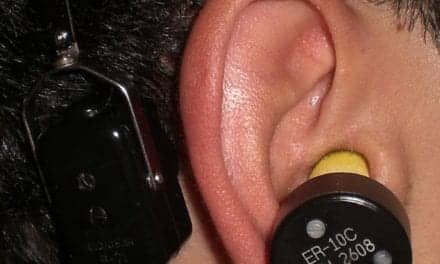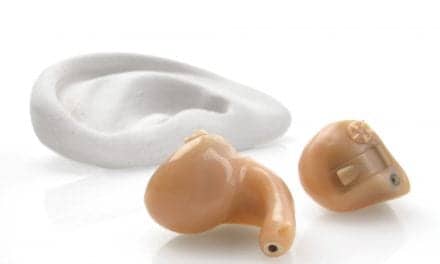We work in a supercharged industry of digital hearing aid technology that changes monthly. Each year, hundreds of pages are devoted in HR to the challenges related to new fitting technologies, the advances in directionality, the new world of wireless aids, and the science behind algorithms that are allowing people to hear better.
However, this article is about the one tiny device that makes all of these things work: the hearing aid battery. The truth is that, without the zinc air battery, our smorgasbord of advanced digital innovations would not be worth one lick. Hearing aid batteries have played a major role in the evolution of hearing instruments and, in turn, evolved with their needs.
In view of this fact, HR asked Serge Traylor of Energizer Battery Company, St Louis; Tom Begley and Ann Rule of Rayovac/Spectrum Brands, Madison, Wis; Frank Wang of ZeniPower, Guang Dong, China; and Elliott Alexander of Varta-Micropower Battery Company, Miami, to provide information via interviews and written answers on the latest technology and marketing trends influencing their industry. Part 1, presented here, examines the technical aspects of the hearing aid batteries in 2008.
Power, Capacity, and Quality
There will always be three primary technical attributes on which consumers and dispensing professionals judge batteries:
- The battery’s performance within the hearing device (ie, retaining the appropriate power level without “motor-boating” or cutting out);
- Service life (battery capacity); and
- Dependability or consistency.

|
| Serge Traylor, Energizer |
Performance and dependability are two aspects that go hand in hand. “People pay a lot for hearing aids, and consumers and hearing care professionals expect the hearing aid to work consistently, battery to battery, package to package,” says Tom Begley of Rayovac/Spectrum Brands. He points out that experiencing a quality problem with a hearing aid battery—which costs a tiny fraction of the hearing instrument—is something that no one wants to see.
Battery service life is also important to consumers; people naturally want a battery that provides appropriate power and long life at a fair price. Battery size constraints limit the amount of material—and hence energy—packed into the metal “can” of the battery cell. The challenge for battery manufacturers is what to do with that space to maximize performance and get more active ingredients inside the can without risking product failure.
“In general, all hearing aid batteries are very similar,” notes Serge Traylor of Energizer Battery Company. “But there are some obvious distinguishing features between brands, such as the number of air holes and tab sizes. Internally, there are also some differences in chemical formulation, materials used, and physical design of the parts.”
All electronic features consume energy. As more features are added to a hearing aid, more energy is consumed. Therefore, battery life and hearing aid features have a kind of yin-yang relationship. The goal of most hearing instrument R&D departments is to engineer their devices for a battery life of about 1 week. However, when battery manufacturers come up with new strategies and technologies for extending battery life, it’s more likely the device manufacturers will opt for the addition of more features to their aids before opting for increased battery life. The net result is that battery service life has remained relatively constant.

|
| Tom Begley, Rayovac |
Tom Begley recounts a letter from a consumer whose concerns—aimed at the entire hearing aid battery industry—are reflective of many consumers:
- Why can’t hearing aids last as long as watch batteries? and
- Is there a conspiracy among the battery manufacturers to produce batteries with shorter battery life?
The answer to the first question centers on the energy drain characteristics and battery chemistries involved in watches and watch batteries. “[The second question] is a bit like the conspiracies related to lightbulb manufacturers, General Motors, etc,” says Begley smiling. “One of the points in my response was that the Size 10 battery that Rayovac introduced in 1986 had 50 milliAmp hours (mAh). Today, the Size 10 battery that Rayovac makes has 105 mAh. What that means to the consumer is that, if the battery lasted 1 week in 1986, it would last 2 weeks today in that same hearing aid. We’ve literally doubled the battery life in 20 years. However, [this added capacity] has also enabled hearing aid manufacturers to add more features to their devices. In other words, partly due to the increased battery performance, today’s hearing aids offer a lot more benefit and hopefully provide consumers with a better quality of life.”
The Mini-BTE Revolution and New Power Requirements
The hearing aid market has changed dramatically in the last 4 years. In 2004, only a quarter (25%) of all hearing aids dispensed were behind-the-ear (BTE) type aids, whereas today more than half (51%) are BTEs, as a result of the smaller open-fit, thin-tube, and receiver-in-canal (RIC) BTEs. Relative to the battery market, it has meant a similar shift to Size 312, 13, and 10 batteries.
“These new BTEs use more Size 13 and 312 batteries, [rather] than the smaller A10,” says Frank Wang of ZeniPower. “Our company has seen this change in battery sizes during the last 2 years.”

|
| Frank Wang, ZeniPower |
High power applications. Several new hearing instrument product lines—including offerings from Siemens, Starkey, Phonak, and Oticon—have been introduced with wireless features that connect the hearing aids to each other for binaural processing and/or to peripheral devices. And that requires power. In some cases, lots of it.
“Several hearing instrument manufacturers have launched Bluetooth hearing aids, which require a minimum of 6 mA of current drain,” Wang says. “Service life at such high drain levels can be maintained only with the best high-performance batteries. The new class of wireless/Bluetooth products do need higher drain and working voltage, and dispensers can take advantage of ZeniPower batteries, which have a top performance rating due to its patented cathode technology.”
Rayovac has also recently developed, in partnership with Phonak, a new high-power battery that was introduced to work where there is a requirement for greater than 130 dB output and/or greater than a 4 mA drain. The new battery line, Rayovac Extreme, was launched at the American Academy of Audiology (AAA) convention in April. “Essentially, the device was designed on the same platform as a cochlear battery,” explains Ann Rule of Rayovac/Spectrum Brands. “It satisfies the high-drain requirements of this new class of hearing instruments.”
“Both Rayovac and Varta-Microbattery (XGen) introduced new batteries for Sizes 312 and 13 for this year,” says Elliott Alexander of Varta-Micropower Battery Company. “These batteries have higher power discharge capabilities and are designed to support the new wireless/Bluetooth-compatible hearing aids. If more demand comes to the market [in response to these high-power applications], other battery manufacturers will easily be able to tweak their battery formulations to offer cells with higher power capabilities.”
“Over the past 5 years,” says Traylor, “hearing aids have incorporated more features, as the industry tries to make aids more user-friendly. These features—like Bluetooth compatibility—demand higher current from the battery. A few years ago, the IEC added two new tests to the [test regimen], recognizing this shift toward higher-drain digital aids. So, today, there are four tests in the [test regimen], but discussions are under way to remove the two older tests. In addition, there is some consideration to adding a test to represent cochlear aids.”
Keeping it simple. Although high-power batteries are vital for some applications, they often confuse people. Some consumers have the mistaken belief that a high-power battery will always be better; however, in hearing aids with standard power requirements, the only difference the consumer will see in a high-power battery is a shorter service life.
“It’s important to use the correct battery for the application,” Begley says. “Unless a high-power battery is absolutely required by the hearing aid manufacturer, the dispensing professional or consumer should try a standard battery in the device. If they find poor sound quality, intermittency, or low battery warnings, then they might want to try one of the new high-powered batteries.”
Zinc Air: An Almost Perfect Technology

|
| Elliott Alexander, Varta-Microbattery |
The zinc air battery is a technological marvel. Simply put, if it were not for the pesky holes necessary to drive the chemical reaction inside the battery can, zinc air would be the favorite battery chemistry of the world. However, the holes—which are opened when the tab is removed and allow oxygen to power the chemical reaction inside the battery cell—make the batteries more susceptible to drying out or being affected by moisture.
Rust and corrosion. In extremely humid environments, as well as some BTE fittings where perspiration or outdoor activities become an issue, water can be absorbed into the zinc air cell. In some cases, this can lead to the battery shutting off or, in worse-case scenarios, corrosion, bulging, or rusting of the cell. While usually not a problem, several companies have tweaked or are tweaking their designs to be more tolerant of humid environments.
“Rust is a very important issue, as it is a leading cause of damage and costly repairs in a hearing aid,” says Traylor. “In addition to corroding the components in the aid, it can result in difficulty removing the battery from the aid and, in turn, damaging the door on the aid. In order to reduce the occurrence of rust in a hearing aid, it is important to use a battery that is less prone to rusting.”
The trend toward mini-BTEs has also increased the exposure of batteries to the environment. “The mini-BTEs, because they’re worn on the head, are more prone to sweat, perspiration, and the elements,” Begley says. “Using either an electrolytic plating or a stainless steel can has been found to meet the issues of rust and corrosion.”
Environmental issues. Hearing aid battery manufacturers have traditionally added mercury to reduce leakage and add some capacity to the cell. The 1996 Mercury-Containing and Rechargeable Battery Management Act restricts the addition of mercury to a maximum of 25 mg per button cell battery (most button cells reportedly contain less than half that amount). Some states, including Maine and Connecticut, have also passed various measures for the reduction or elimination of mercury-containing products. NEMA—the national organization for electrical manufacturers that includes as members Duracell, Energizer, Panasonic, Rayovac, and Renata—announced its commitment to eliminate mercury from button cell batteries within the next 3 years.
“Concern over environmental issues varies by region, market, and customer,” Traylor says. “Legislative pressures exist in some areas, and there are some customers who are looking for more environmentally friendly products. To address the growing concern, NEMA, which includes most battery manufacturers, has agreed to eliminate the use of mercury in hearing aid batteries and other button cells by June 2011.”

|
| Ann Rule, Rayovac |
Rayovac is introducing a mercury-free battery in the fourth quarter of this year. “We’ve put a lot of research into producing a battery that is as close as possible to the capacity of the batteries we offer today,” Begley says. “The average hearing aid consumer won’t see any real change in capacity. However, those who have severe or profound losses and use high-powered devices may see a [slightly reduced service life].”
Rule says that Rayovac has dedicated itself to becoming a “green” company, and its new battery is part of an ISO 14001 accreditation that specifies requirements for an effective Environmental Management System. “This is an important issue facing the world today,” Rule says, “and we developed a mercury-free alkaline battery several years ago. The batteries we’re going to be producing are not only mercury-free, but much of our packaging will be made of recycled materials and will, in turn, be recyclable. We’ve also taken a look at our company’s global operational processes and made changes to become more environmentally friendly.”
Rechargeable Batteries
Several of the experts interviewed acknowledged that rechargeable batteries, which use nickel-metal hydride (Ni-MH) chemistry, are appealing to a subset of consumers and may gain greater prominence in the future. However, they question the current economics for rechargeable batteries in hearing aids. The average retail value of a conventional hearing aid battery is about $1, and most consumers use 30 to 50 batteries per hearing aid each year. In contrast, a rechargeable hearing aid battery costs about $30, and the consumer must also purchase a recharging unit (typically, about $50).
They also raise performance and convenience concerns. “Rechargeable hearing aid batteries are a niche segment in which we don’t see much growth in the future,” says Traylor. “They are still rather inconvenient to use, having to be removed and placed in a charger every night. Often, additional batteries must be kept on hand due to their relatively short life. Aids that incorporate a rechargeable battery may gain in popularity as consumers become more accustomed to the ‘pod charging’ habit. However, we have yet to see these units reach the satisfaction level of primary batteries.”
“Zinc air batteries are truly a fabulous design…” Alexander says. “A zinc air battery offers over five times the energy capacity of similar-size alkaline button cells. While some future hearing aids may be designed with rechargeable batteries or battery packs, the zinc air battery will likely dominate the market for the next 15 years or more. Even the Ni-MH batteries recently offered for sizes 10, 13, 312, and 675 have milliAmp-hour capacities of only 11% that of the equivalent-size zinc air battery. With such lower mAh capacities, it’s possible a rechargeable cell might not last a full day of usage without requiring charging. Clearly, zinc air batteries appear to be more practical for the typical user.”
Begley believes this technology is still evolving. “Rayovac is very involved in rechargeable Ni-MH batteries in consumer products,” he says. “It’s not that we don’t have an interest in rechargeables; we just don’t believe that the Ni-MH technologies that are available today are the best answer for meeting consumer needs in our market…. The next generation of rechargeable technology? It’s possible.” He says that, in the future, a longer life lithium-based battery might provide the answer, but several hurdles, including potential health risks, would have to be resolved.?It might also require the industry to move to a 3-volt system.

|
| Part 2 of this article will explore marketing issues related to hearing aid batteries. |
A niche market. Wang essentially agrees, but maintains that rechargeable hearing aid batteries do represent a good option for patients with dexterity problems or who simply have other needs and preferences. “Rechargeable Ni-MH batteries are a new product by Varta, and it will for sure take some market share from zinc air batteries, but not much,” Wang states. “If you consider the Size AA rechargeable [consumer] battery, it should be understood that these will never take the market from AA alkaline. The main marketing point for Ni-MH is the convenience of not changing the small cells [on a regular basis], and the technology is offered by Siemens and ReSound hearing aids using a special charger that does not require changing the battery by hand.”
Like Begley, he also believes lithium-ion cells could be possible, citing their use in cochlear implants. “I would think this could be a more fundamental change in hearing aid batteries than Ni-MH. [Looking at the] cell phone history, a built-in lithium battery in a hearing aid is something people could [embrace]…. However, the minimum requirement of lasting 1 day is still a big challenge for miniature lithium-ion cells.”




